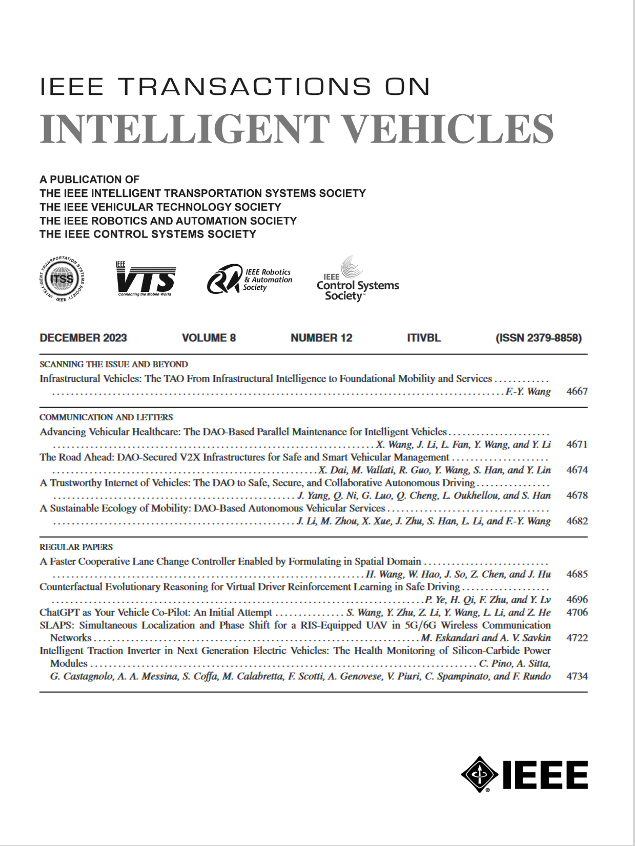自动驾驶汽车变道安全轨迹优化与高效离线鲁棒模型预测控制
IF 14.3
1区 工程技术
Q1 COMPUTER SCIENCE, ARTIFICIAL INTELLIGENCE
引用次数: 0
摘要
在不同的道路条件下以不同的速度驾驶自动驾驶汽车是一项重大挑战。为了解决这一挑战,我们提出了一种分层控制策略,该策略由第一层基于优化的轨迹规划器和第二层采用路径跟踪的高效离线鲁棒方法组成。考虑到车辆参数的不确定性,所提出的分层结构可以处理不同路面条件和速度的多种场景。在第一层,运动规划器灵活运用Pontryagin极大值原理(PMP)和碰撞时间(TTC)方法,在与前方车辆和相邻车道车辆交互时生成安全最优变道轨迹,在保持安全距离的同时提高乘坐舒适性。在第二层,将具有终端约束的高效离线鲁棒模型预测控制(RMPC)应用于线性变参数系统。利用线性矩阵不等式(LMI)技术,优化问题在鲁棒性满足输入和输出约束的同时适应参数不确定性。为了强调卓越的性能,我们考虑将我们提出的方法与几种最先进的方法进行比较。因此,对比仿真结果表明,我们的安全最优轨迹生成方法在路径平滑方面优于时空廊道方法。所提出的方法(即高效-离线RMPC)在路径跟踪性能和参数不确定性处理方面优于离线MPC方法,而在计算复杂度降低方面优于在线RMPC方法。此外,所有方法都通过高保真动态测试车辆控制软件(即CarSim)使用联合仿真和测试平台进行验证。本文章由计算机程序翻译,如有差异,请以英文原文为准。
Safe Trajectory Optimization and Efficient-Offline Robust Model Predictive Control for Autonomous Vehicle Lane Change
Driving autonomous vehicles through diverse road conditions at various high speeds poses a significant challenge. To address this challenge, we propose a hierarchical control strategy consisting of an optimization-based trajectory planner in the first layer and an efficient-offline robust method employing path tracking in the second layer. Considering vehicle parametric uncertainties, the proposed hierarchical structure addresses multiple scenarios with varying road surface conditions and velocities. In the first layer, using the Pontryagin maximum principle (PMP) flexibly with the time-to-collision (TTC) method, the motion planner generates a safe-optimal lane-change trajectory when interacting with forward vehicles and adjacent-lane vehicles to improve ride comfort while maintaining safe distances. In the second layer, the efficient offline robust model predictive control (RMPC) with terminal constraints is applied to a linear parameter varying (LPV) system. Utilizing linear matrix inequality (LMI) techniques, the optimization problem accommodates parametric uncertainties while robustly satisfying input and output constraints. To emphasize superior performance, we have considered comparing our proposed approach with several state-of-the-art methods. Therefore, comparative simulation results have shown that our safe-optimal trajectory generation is better than the Spatio-Temporal Corridors method regarding path smoothy. The proposed approach (i.e., efficient-offline RMPC) then outperforms the offline MPC method in terms of path-tracking performance and parametric uncertainty handling while outperforming the online RMPC method in terms of computational complexity reduction. Further, all methods are verified using a co-simulation and testing platform via a high-fidelity dynamics testing vehicle control software (i.e., CarSim).
求助全文
通过发布文献求助,成功后即可免费获取论文全文。
去求助
来源期刊

IEEE Transactions on Intelligent Vehicles
Mathematics-Control and Optimization
CiteScore
12.10
自引率
13.40%
发文量
177
期刊介绍:
The IEEE Transactions on Intelligent Vehicles (T-IV) is a premier platform for publishing peer-reviewed articles that present innovative research concepts, application results, significant theoretical findings, and application case studies in the field of intelligent vehicles. With a particular emphasis on automated vehicles within roadway environments, T-IV aims to raise awareness of pressing research and application challenges.
Our focus is on providing critical information to the intelligent vehicle community, serving as a dissemination vehicle for IEEE ITS Society members and others interested in learning about the state-of-the-art developments and progress in research and applications related to intelligent vehicles. Join us in advancing knowledge and innovation in this dynamic field.
 求助内容:
求助内容: 应助结果提醒方式:
应助结果提醒方式:


